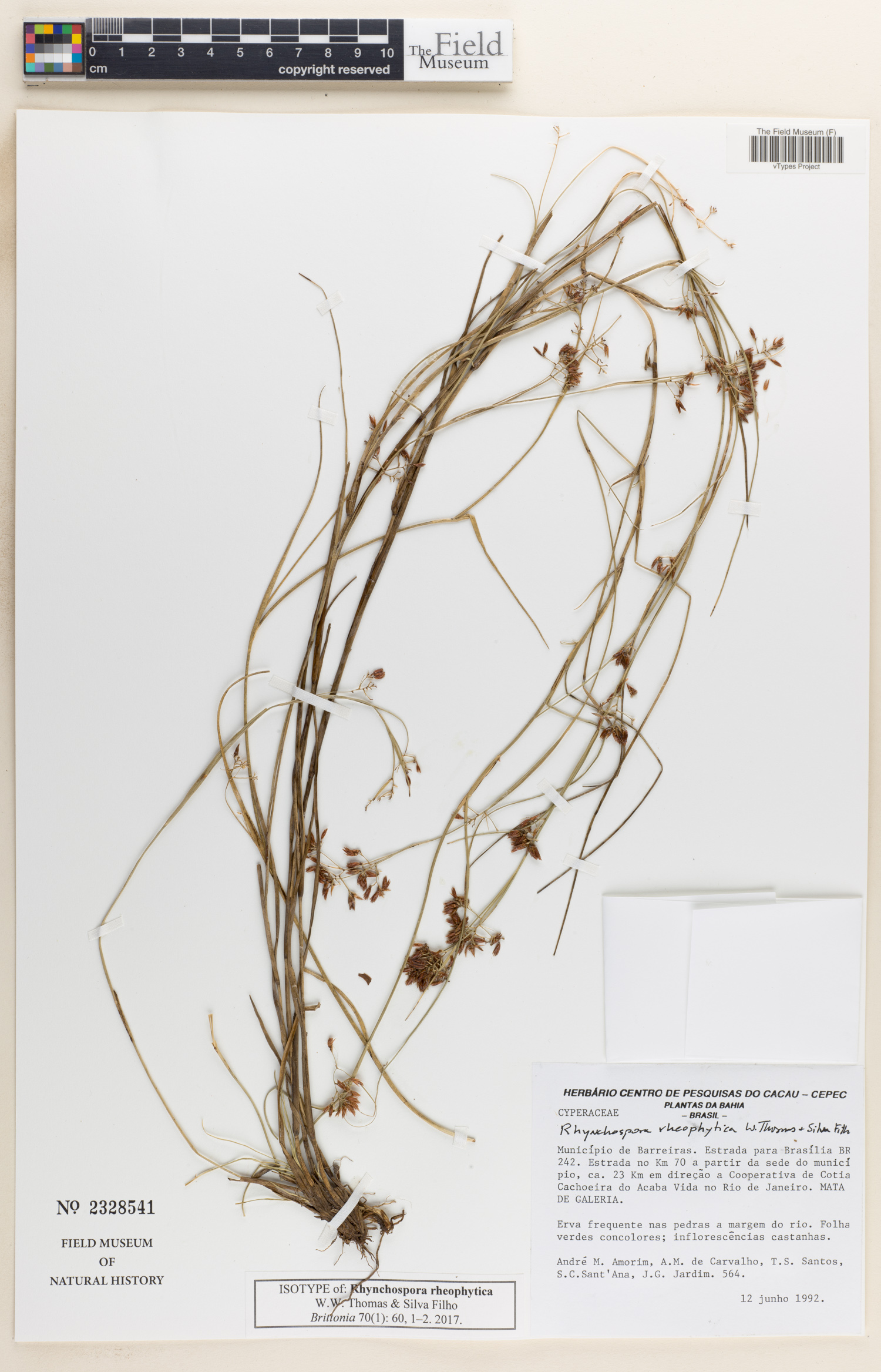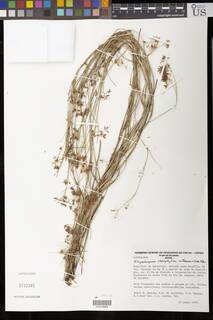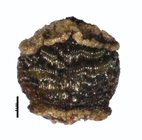Cyperaceae taxon details
Rhynchospora rheophytica W.W.Thomas & Silva Filho
1681214 (urn:lsid:marinespecies.org:taxname:1681214)
accepted
Species
terrestrial
Thomas, W. W.; da Silva Filho, P. J. S. (2018). Rhynchospora rheophytica (Cyperaceae), a new species from western Bahia, Brazil. Brittonia, 70(1): 60-64., available online at https://doi.org/10.1007/s12228-017-9499-8
page(s): 60 [details]
page(s): 60 [details]
Holotype CEPEC
55360, geounit Bahia
55360, geounit Bahia
Holotype CEPEC
55360, geounit Bahia [details]
55360, geounit Bahia [details]
Description Plant in small clumps, 50–113 cm tall, apparently lax, glabrous (Fig. 1). Culms ±tereteand slightly wrinkled...
Description Plant in small clumps, 50–113 cm tall, apparently lax, glabrous (Fig. 1). Culms ±tereteand slightly wrinkled longitudinally, probably upon drying, 1–1.5 mm in diam. Internodes ca. 8, 411.5 cm long, increasing in length distally; nodes not swollen, slightly darkened,
occasionally sprouting new plantlets. Leaves basal and cauline; basal leaves no longer present; cauline leaves stiff and analiculate,
diminishing in size distally, becoming flat and flexible, the lower ones (including sheath) 1516 cm long, the sheath 3.5–4.5 cm long, the summit of the inner band (the portion of the sheath opposite the ligule) truncate, the blade 11–12.5 cm long, 1.5–2.5 mm wide, gradually tapering distally, adaxially smooth with veins not evident, abaxially longitudinally veined. Inflorescence a series of corymbodia
(coflorescences) on lax peduncles, the basal corymbs (including the peduncle) up to 15 cm long, the distal corymbs 3–6 cm long; secondary and tertiary axes subtended by an inflorescence bract surrounding a bladeless prophyll, the inflorescence bracts 1.5–7 mm long, the bladeless prophyll ± 1 mm long, the pedicels ±1–1.5 × 0.2–0.4 mm. Spikelets ca. 20–40 per corymb, mostly separate and not fasciculate, roughly ellipsoidal, 5–5.5 × 2 mm, brown; the basal two spikelet scales smaller than the rest, slightly cartilaginous, stramineous, the basalmost scale 3 × 3 mm, with the median nerve projecting out as a 0.5 mm long mucro, the secondscale2×3mm, alsowitha0.5mm long mucro; remaining scales 7–9, obscurely distichous, the largest 4 × 1.5 mm, narrowly obovate, cucullate, ferrugineous, chartaceous, the tip acuminate. Flowers bisexual or functionally staminate; basal 2–4 flowers of the spikelet bisexual, the next 2 or 3 functionally staminate; perianth bristles absent; stamens 3, the filaments 2.5–3 mm long, the anthers 1.7–1.8 mm long; stigma and style 2.5 mmlong. Achene broadly obovate, 0.7–0.8 ×0.8–0.9 mm, orange-brown to black, rugose, with 4 or 5 (6) ridges, the base flattened and flared around the stipe; persistent style base depressed, strap-like, 0.3–0.4 × 0.8–0.9 mm [details]
occasionally sprouting new plantlets. Leaves basal and cauline; basal leaves no longer present; cauline leaves stiff and analiculate,
diminishing in size distally, becoming flat and flexible, the lower ones (including sheath) 1516 cm long, the sheath 3.5–4.5 cm long, the summit of the inner band (the portion of the sheath opposite the ligule) truncate, the blade 11–12.5 cm long, 1.5–2.5 mm wide, gradually tapering distally, adaxially smooth with veins not evident, abaxially longitudinally veined. Inflorescence a series of corymbodia
(coflorescences) on lax peduncles, the basal corymbs (including the peduncle) up to 15 cm long, the distal corymbs 3–6 cm long; secondary and tertiary axes subtended by an inflorescence bract surrounding a bladeless prophyll, the inflorescence bracts 1.5–7 mm long, the bladeless prophyll ± 1 mm long, the pedicels ±1–1.5 × 0.2–0.4 mm. Spikelets ca. 20–40 per corymb, mostly separate and not fasciculate, roughly ellipsoidal, 5–5.5 × 2 mm, brown; the basal two spikelet scales smaller than the rest, slightly cartilaginous, stramineous, the basalmost scale 3 × 3 mm, with the median nerve projecting out as a 0.5 mm long mucro, the secondscale2×3mm, alsowitha0.5mm long mucro; remaining scales 7–9, obscurely distichous, the largest 4 × 1.5 mm, narrowly obovate, cucullate, ferrugineous, chartaceous, the tip acuminate. Flowers bisexual or functionally staminate; basal 2–4 flowers of the spikelet bisexual, the next 2 or 3 functionally staminate; perianth bristles absent; stamens 3, the filaments 2.5–3 mm long, the anthers 1.7–1.8 mm long; stigma and style 2.5 mmlong. Achene broadly obovate, 0.7–0.8 ×0.8–0.9 mm, orange-brown to black, rugose, with 4 or 5 (6) ridges, the base flattened and flared around the stipe; persistent style base depressed, strap-like, 0.3–0.4 × 0.8–0.9 mm [details]
Cyperaceae Working Group. (2025). [see How to cite]. Global Cyperaceae Database. Rhynchospora rheophytica W.W.Thomas & Silva Filho. Accessed at: https://cyperaceae.org/aphia.php?p=taxdetails&id=1681214 on 2025-09-14
Date
action
by
2024-12-10 11:47:54Z
unchecked
db_admin
![]() The webpage text is licensed under a Creative Commons
Attribution 4.0 License
The webpage text is licensed under a Creative Commons
Attribution 4.0 License
Nomenclature
original description
Thomas, W. W.; da Silva Filho, P. J. S. (2018). Rhynchospora rheophytica (Cyperaceae), a new species from western Bahia, Brazil. Brittonia, 70(1): 60-64., available online at https://doi.org/10.1007/s12228-017-9499-8
page(s): 60 [details]
basis of record Plants of the World Online (POWO). , available online at https://powo.science.kew.org/ [details]
page(s): 60 [details]
basis of record Plants of the World Online (POWO). , available online at https://powo.science.kew.org/ [details]
 Present
Present  Inaccurate
Inaccurate  Introduced: alien
Introduced: alien  Containing type locality
Containing type locality
Holotype CEPEC
55360, geounit Bahia [details]
55360, geounit Bahia [details]
From editor or global species database
Description Plant in small clumps, 50–113 cm tall, apparently lax, glabrous (Fig. 1). Culms ±tereteand slightly wrinkled longitudinally, probably upon drying, 1–1.5 mm in diam. Internodes ca. 8, 411.5 cm long, increasing in length distally; nodes not swollen, slightly darkened,occasionally sprouting new plantlets. Leaves basal and cauline; basal leaves no longer present; cauline leaves stiff and analiculate,
diminishing in size distally, becoming flat and flexible, the lower ones (including sheath) 1516 cm long, the sheath 3.5–4.5 cm long, the summit of the inner band (the portion of the sheath opposite the ligule) truncate, the blade 11–12.5 cm long, 1.5–2.5 mm wide, gradually tapering distally, adaxially smooth with veins not evident, abaxially longitudinally veined. Inflorescence a series of corymbodia
(coflorescences) on lax peduncles, the basal corymbs (including the peduncle) up to 15 cm long, the distal corymbs 3–6 cm long; secondary and tertiary axes subtended by an inflorescence bract surrounding a bladeless prophyll, the inflorescence bracts 1.5–7 mm long, the bladeless prophyll ± 1 mm long, the pedicels ±1–1.5 × 0.2–0.4 mm. Spikelets ca. 20–40 per corymb, mostly separate and not fasciculate, roughly ellipsoidal, 5–5.5 × 2 mm, brown; the basal two spikelet scales smaller than the rest, slightly cartilaginous, stramineous, the basalmost scale 3 × 3 mm, with the median nerve projecting out as a 0.5 mm long mucro, the secondscale2×3mm, alsowitha0.5mm long mucro; remaining scales 7–9, obscurely distichous, the largest 4 × 1.5 mm, narrowly obovate, cucullate, ferrugineous, chartaceous, the tip acuminate. Flowers bisexual or functionally staminate; basal 2–4 flowers of the spikelet bisexual, the next 2 or 3 functionally staminate; perianth bristles absent; stamens 3, the filaments 2.5–3 mm long, the anthers 1.7–1.8 mm long; stigma and style 2.5 mmlong. Achene broadly obovate, 0.7–0.8 ×0.8–0.9 mm, orange-brown to black, rugose, with 4 or 5 (6) ridges, the base flattened and flared around the stipe; persistent style base depressed, strap-like, 0.3–0.4 × 0.8–0.9 mm [details]
To European Nucleotide Archive, ENA (Rhynchospora rheophytica)
To Field Museum Herbarium (Rhynchospora rheophytica W. W. Thomas & Silva Filho F2328541 isotype 1)
To GenBank (3 nucleotides; 0 proteins)
To International Plant Names Index (IPNI)
To Plants of the World Online
To Royal Botanic Gardens, Kew (Rhynchospora rheophytica K000544241 isotype 1)
To US Herbarium (Rhynchospora rheophytica US3732341 type 1)
To Field Museum Herbarium (Rhynchospora rheophytica W. W. Thomas & Silva Filho F2328541 isotype 1)
To GenBank (3 nucleotides; 0 proteins)
To International Plant Names Index (IPNI)
To Plants of the World Online
To Royal Botanic Gardens, Kew (Rhynchospora rheophytica K000544241 isotype 1)
To US Herbarium (Rhynchospora rheophytica US3732341 type 1)








